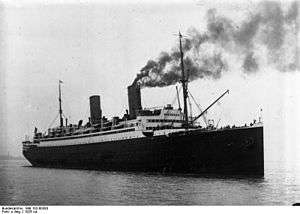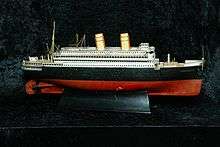SS Columbus (1924)
 | |
| History | |
|---|---|
| Name: | SS Columbus |
| Namesake: | Christopher Columbus |
| Owner: | Norddeutscher Lloyd |
| Operator: | Germany |
| Port of registry: | Hamburg, Germany |
| Route: | Hamburg- New York |
| Ordered: | 1914 |
| Builder: | Schichau, Danzig, Germany |
| Completed: | 1922 |
| Maiden voyage: | Mid-1924 |
| In service: | 1924 |
| Out of service: | 1939 |
| Renamed: | 1914; Hindenburg to Columbus; 1920 |
| Refit: | 1929 |
| Struck: | 1939 |
| Homeport: | Bremen |
| Motto: | "Columbus' ship" |
| Nickname(s): | "Germany's Merchant Ship" |
| Fate: | Scuttled by crew to avoid capture by Royal Navy. |
| Status: | latitude 38 degrees, 2 minutes N, longitude 65 degrees, 33 minutes W |
| Notes: | Served Germany for 15 years |
| General characteristics | |
| Class and type: | Hindenburg |
| Tonnage: | 32354 GRT (1924-29), 32565 GRT (1929-39)[1] |
| Length: | 750 ft (230 m)[1] |
| Beam: | 83 ft (25 m)[1] |
| Height: | 49 ft (15 m)[1] |
| Decks: | 8 |
| Propulsion: | Triple-expansion reciprocating engines (1924-29), Steam turbine engines (1929-39); Twin screw[1] |
| Speed: | Before refit: 18 knots (33 km/h) After refit: 20 knots (37 km/h)[1] |
| Boats & landing craft carried: | 24 |
| Capacity: | 1750 passengers |
The Columbus, laid down before the start of World War I, was originally to be named Hindenburg. However, her then-sister, originally named Columbus, was handed over to the White Star Line after the war as part of reparations in 1920. The Allies allowed the Norddeutscher Lloyd (NDL), her owners, to keep the remaining ship. NDL decided to give her the name of her departed sister, now the British Homeric. Construction, which had been held up by the war, resumed at Schichau Shipyards in Danzig, Germany.
Construction and maiden voyage
Material shortages caused by the war delayed her completion until 1922. She made her maiden voyage in April 1924. At the time, she was the German merchant marine's largest, fastest ocean liner.
She measured 32,581 gross tonnage, was 775 feet (236 m) long with 1,750 cabins for luxury, first, second and tourist class passengers. Her maximum speed was 23 knots. "She had been chartered for a number of years by Cooks Travel Agency in New York and cruised into West Indian waters about every two weeks with occasional trips around South America and Africa."[2]:5
She was one of the first liners to have an outside swimming pool installed on her top deck, as well as a platform for night-time dancing. She had triple-expansion steam engines and was quite popular and convinced NDL that larger passenger liners were feasible.
Later career

With the building of the Bremen and Europa, the Columbus was supplanted as the queen of the NDL fleet. In 1929, she was given a refit to make her resemble her younger, larger and faster running mates. This included the addition of two larger smokestacks and replacement of the reciprocating engines with geared steam turbines.
She left Bremerhaven on 20 June 1939. At the outbreak of World War II in September 1939, Columbus was ordered to return to Germany at once. The Royal Navy was on the lookout for enemy ships. Putting her passengers ashore at Havana, Cuba, her captain and crew sped to Veracruz, evading the British. In early Nov., they received orders to attempt a blockade run to Germany. On 14 Dec. the Columbus departed Veracruz, escorted by seven American destroyers through the American coastal neutrality zone.[2]:68,13-23
On 19 December the British destroyer HMS Hyperion sighted Columbus about 400 miles off the coast of Virginia. The still neutral American heavy cruiser Tuscaloosa was also in the area, and silently observed the two ships. Rather than surrender the ship, her crew scuttled her, and she burned and sank. Her passengers and crew, 576 crewmembers, including boys, stevedores and nurses, were taken aboard Tuscaloosa as rescued seamen, not as prisoners of war as they would have been had the British picked them up. Tuscaloosa took all personnel to New York City. In 1939, 411 German nationals from the Columbus were sent to Fort Stanton, New Mexico.[3] [4] On 18 Jan. 1940, 512 crewmen were moved to Angel Island. In Oct., 8 officers were able to escape on the Asama Maru.[2]:26-43,50 After the end of war many returned to Germany.
See also
- Escape from Fort Stanton
- RMS Homeric - The sister ship of Columbus.
References
- 1 2 3 4 5 6 Harnack, Edwin P (1938) [1903]. All About Ships & Shipping (7th ed.). London: Faber and Faber. p. 549.
- 1 2 3 Giese, O., 1994, Shooting the War, Annapolis: United States Naval Institute, ISBN 1557503079
- ↑ "Interns At New Camp", St. Joseph News-Press, March 18, 1941: 8, retrieved May 4, 2012.
- ↑ J. Burton, M. Farrell, F. Lord, R. Lord. Confinement and Ethnicity: An Overview of World War II Japanese American Relocation Sites, "Department of Justice Internment Camps: Fort Stanton, New Mexico" (National Park Service) Retrieved 13 Jun 2014.
External links
| Wikimedia Commons has media related to Columbus (II). |